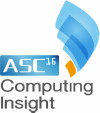 Four teams in the Asia Student Supercomputer Challenge decided to stake out the middle ground in the competition with clusters that aren’t too small and aren’t too big. Is their “just right” approach going to get them into the winners’ circle at ASC16? Let’s meet the teams and see what they’re packing…
Four teams in the Asia Student Supercomputer Challenge decided to stake out the middle ground in the competition with clusters that aren’t too small and aren’t too big. Is their “just right” approach going to get them into the winners’ circle at ASC16? Let’s meet the teams and see what they’re packing…
Dalian University of Technology: Aided as usual by our trusty #2 translator Kensey, we interviewed a representative from Team Dalian. Everything seems to be going fine for the team, except for learning the new Inspur hardware. They’ve been reading the manuals, which is a good thing.
Speaking of manuals, there really isn’t one for Tianhe-2, the biggest supercomputer in the world. Our interviewee bemoans this and wishes he had the whole manual for the behemoth. Dalian’s own cluster is considerably smaller than Tianhe-2. They eventually end up running seven nodes, each with a matching NVIDIA K80 card.
Huazhong University of Science and Technology: Huazhong (or HUST) is the host of this year’s cluster competition and thus the home team. The beginning of the interview shows how horrible I am at pronouncing Chinese names – particularly university names. Our #1 translator, Wallis, is helping us get past the language and noise barriers.
The interviewee discusses how they might be using eight or ten nodes, but aren’t quite sure at this point. They eventually end up using eight nodes with CPUs, with six K80s spread throughout the rack.
Shanghai Jiao Tong University: In the video, we’re speaking with the captain of Team Shanghai, ably assisted by our #2 translator, Kensey.
The team anticipates running eight nodes with six K80 accelerators. It’s the third time that team Shanghai has competed in the ASC, and they notched a trip to ISC’14 due to their high finish in ASC14.
I tried to stir up some dissent within the team, but the language barrier got in the way of my japes. Then I tried to stir up some interpersonal trouble by asking him if he thought Kensey was cute. He agreed, then I warned him that her massive (6-foot plus) boyfriend would pound him into fine dust if he made a move on her. He seemed to get the message, so there weren’t any fights to liven up an already lively competition.
University of Miskolc (Hungary): Team Hungary is always a fun team to work with. In the video, we interview team member David, who advises me that calling him ‘Dave’ is a bit too familiar.
This is the third time the team has competed at ASC, sporting a mixed team of new comers and competition veterans. In the video, we compare the hair style of one of the team members to his 2014 ‘do.
Back then, I said it was the most advanced hair style ever seen at a cluster competition. In 2016, it’s only a shadow of its former glory – due to a girlfriend and her scissors.
This year the team is driving a mid-sized eight-node cluster that’s configured old-school – CPU only. When we’re interviewing the team, they’re busy working on optimizing their applications with good results, according to David.
That covers the teams with the mid-sized servers; next up are the heavyweights. No one gets into the heavyweight club with less than nine nodes… stay tuned…
Posted In: Latest News, ASC 2016 Wuhan
Tagged: supercomputing, HPC, Asia Student Supercomputer Challenge, Huazhong University of Science & Technology, Shanghai Jiao Tong University, University of Miskolc, ASC16, Dalian University of Technology, Configurations, ASC 2016
